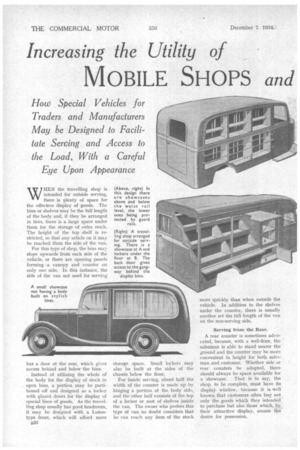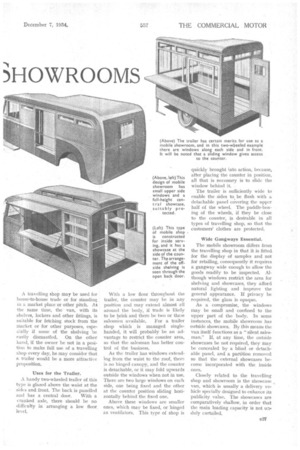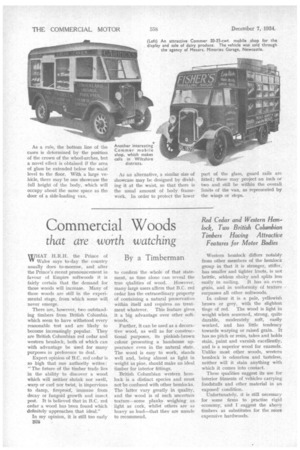Increasing the Utility of
Page 40

Page 41

Page 42

If you've noticed an error in this article please click here to report it so we can fix it.
MOBILE SHOPS and
SHOWROOMS
How Special Vehicles for Traders and Manufacturers May be Designed to Facilitate Serving and Access to the Load, With a Careful Eye Upon Appearance
WHEN the travelling shop is intended for outside serving, there is plenty of space for the effective display of goods. The bins or shelves may be the full length of the body and, if they be arranged in tiers, there is a large space under them for the storage of extra stock. The height of the top shelf is restricted, so that any article on it may be reached from the side of the van.
For this type of shop, the bins may slope upwards from each side of the vehicle, or there are opening panels forming a canopy and counter on only one side. in this instance, the side of the van not used for serving
has a door at the rear, which gives access behind and below the bins.
Instead of utilizing the whole of the body for the display of stock in open bins, a portion may be partitioned off and designed as a locker with glazed doors for the display of special lines of goods. As the travelling shop usually has good headroom, it may be designed with a Lutontype front, which will afford more storage space. Small lockers may also be built at the sides of the chassis below the floor.
For inside serving, about half the width of the counter is made up by hinging a portion of the body side, and the other half consists of the top of a locker or nest of shelves inside the van. The owner who prefers this type of van no doubt considers that he can reach any item of the stock
more quickly than when outside the vehicle. In addition to the shelves under the counter, there is usually another set the full length of the van on the non-serving side.
serving from the Rear.
A rear counter is sometimes advocated, because, with a well-floor, the salesman is able to stand nearer the ground and the counter may be more convenient in height for both salesman and customer, Whether side or rear counters be adopted, there should always be space available for a showcase. That is to say, the shop, to be complete, must have its displaY window, because it is well known that customers often buy not only the goods which they intended to purchase but also those which, by:. their attractive display, arouse he desire for possession. A travelling shop may be used for house-to-house trade or for standing in a market place or other pitch. At the same time, the van, with its shelves, lockers and other fittings, is suitable for fetching stock from the market or for other purposes, especially if some of the shelving be easily dismantled. On the other hand, if the owner be not in a position to make full use of a travelling shop every day, he may consider that a trailer would be a more attractive proposition.
Uses for the Trailer.
A handy two-wheeled trailer of this type is glazed above the waist at the sides and front. The back is panelled and has a central door. With a cranked axle, there should be no difficulty in arranging a low floor. level. With a low floor throughout the trailer, the counter may be in any position and may extend almost all around the body, if trade is likely to be brisk and there be two or thrae
salesmen available. For a trailer shop which is managed singlehanded, it will probably be an advantage to restrict the counter area, so that the salesman has better control of the business.
As the trailer has windows extending from the waist to the roof, there is no hinged canopy, and the counter is detachable, or it may fold upwards outside the windows when not in use. There are two large windows on each side, one being fixed and the other at the counter position sliding horizontally behind the fixed one.
Above these windows are smaller ones, which may be fixed, or hinged as ventilators. This type of shop is quickly brought into action, because, after placing the counter in position, all that is necessary is to slide the window behind it. .
The trailer is sufficiently wide to enable the sides to be flush with a detachable panel covering the upper half of the wheel. The paddle-boxing of the wheels, if they be close to the counter, is desirable in all types of travelling shop, so that the customers' clothes are protected.
Wide Gangways Essential.
The mobile showroom differs from the travelling shop in that it is fitted. for the display of samples and not for retailing, consequently it requires a gangway wide enough to allow the goods readily to be inspected. Although windows restrict the area for shelving and showcases, they afford natural lighting and improve the general appearance. If privacy be required, the glass is opaque.
As a compromise, the windows may be small and confined to the upper part of the body. In some instances, the mobile showroom has outside showcases. By this means the van itself functions as a "silent salesman." If, at any time, the outside showcases be not required, they may be concealed by a blind or detachable panel, and a partition removed so that the external showcases become incorporated with the inside ones.
Closely related to the travelling shop and showroom is the showcase van, which is usually a delivery vehicle specially designed to enhance its publicity, value. The showcases are comparatively shallow, in order that the main loading capacity is not unduly curtailed. As a rule, the bottom line of the cases is determined by the position of the crown of the wheel-arches, but a novel effect is obtained if the area of glass be extended below the waist level to the floor. With a large vehicle, there may be one showcase the full height of the body, which will occupy about the same space as the door of a side-loading van. As an alternative, a similar size of showcase may be designed by dividing it at the waist, so that there is the usual amount of body framework. In order to protect the lower part of the glass, guard rails are fitted; these may project an inch or two and still be within the overall limits of the van, as represented by the wings or steps.




























































































